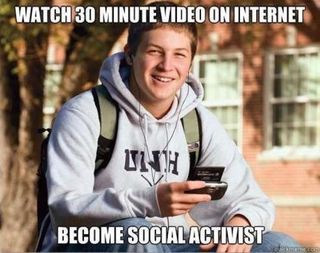
by Ginnia Cheng
As a PR, utilising the power of social media to my clients’ advantage is all part and parcel of my job role. I regularly witness first-hand the rewards that can be reaped both for organisations and their customers when a social media campaign is well executed. Out of work, I’m also a social media fanatic – ok, by fanatic I really mean addict – and I imagine you wouldn’t often run into someone who’s a bigger advocate of social media than I am.
So I don’t criticise social media lightly. It’s just that recently, I’ve been more hesitant to associate as heavily with the ‘social media culture’ that has taken hold of our society. My main gripe is how social media has bred a spectacular escalation in slacktivism – the support of an issue or social cause which one has little or no understanding of, and “that has little or no practical effect other than to make the person doing it feel satisfaction”. This phenomenon’s rise can be single-handedly attributed to the proliferation of social networks, where people can simply click a ‘Like’ or a ‘Share’ button, change their profile picture, or post a status to show they are ‘supporting a cause’.
A perfect case in point is the recent ‘KONY 2012’ video that went viral – so viral, in fact, that it has already been deemed “the most successful viral video of all time” with 100 million views in 10 days. The video, put out by an American charity, aims to raise awareness of Ugandan warlord Joseph Kony’s horrific crimes, and ultimately to encourage policy-makers to make greater efforts to "stop" Kony. Within hours of its release, I’d already seen it posted on pretty much every social media platform I frequent. Very quickly, more and more people on my friend and follower feeds started sharing the video and posting statuses about getting behind the cause – then suddenly, KONY 2012 was trending on Twitter – then celebrities on Twitter started linking to the video – and we all know that once celebs are involved, there’s no turning back. It was like everyone on social networks had been gripped by a frenzy to bring down this evil warlord through ‘Like’ing and ‘Share’ing alone.
A day or two later, critics of the video began to surface, and the charity was accused of having suspicious financial records, oversimplifying social and political issues and using emotional manipulation in the clip. Even the people the video was purporting to save did not react kindly upon viewing it. These criticisms started circulating through social media, and again, suddenly everyone was gripped by a frenzy to attack the charity – many of which, on my feeds anyway, were the very same people who a day ago had declared their undying support to the KONY 2012 campaign. To me, the KONY 2012 video did not just reveal the horrific crimes of a Ugandan warlord, but proved how many people mindlessly ‘get behind’ a cause without putting any thought into – because all they is have to do is click a button or two.
This isn’t the first time that slacktivism has been brought to the limelight. We’ve blogged before about how the Breast Cancer Facebook status campaigns – while not relating to breast cancer in any way – were undeniable in creating buzz and awareness around the disease. However, I can’t help but wonder whether making a status on a social cause allows people feel like they’ve ‘done their part’ and no longer have to make a donation.
Social media has even made it possible for other ‘social networking’ sites to ‘go viral’, and another recent viral phenomenon is social network come ‘online pin board’ Pinterest. It is now the fastest stand-alone site to reach ten million visitors in a month, and the entire site is based on social photo-sharing (most of photos which are not taken by the submitter). While admittedly, I do like going on the site once in a while, this great article by Brian Donovan on Thought Catalog summarises my thoughts on Pinterest – in short, “it’s literally the least amount of information that can be put in front of you and still make you feel like you’re looking at something”.
I truly think that Pinterest illustrates how to make something so popular so quickly in the context of our modern-day time-starved lives – “there’s nothing to understand [on Pinterest]. You just log on and let the pictures wash over as they fly through the air. It’s brilliant in both its simplicity and wildly low estimation of our intellectual demands”. Perhaps other not-so-successful social networks such as the long-forgotten Quora disappeared from the public eye because it required actual thought processes.
All in all, while I’m growing wary of the ‘power of social media’, I’m not going to be checking out of any social networks any time soon. However, I truly hope that as our reliance on social media continues to grow, people start to think before they click, and if they do click, then it doesn’t stop them from actively doing something in support of what they’re clicking.

Recent Comments